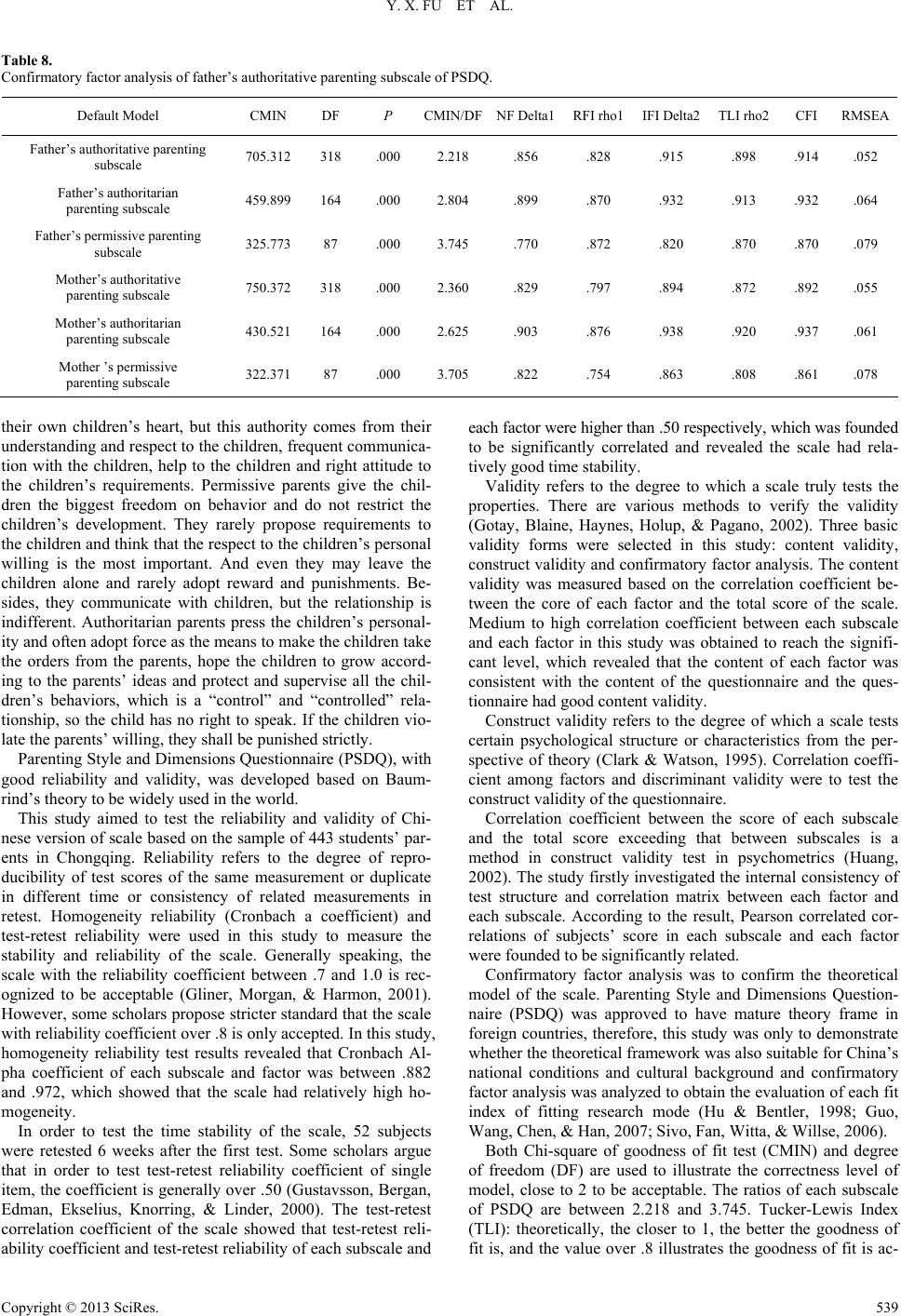
Y. X. FU ET AL.
Table 8.
Confirmatory factor analysis of father’s authoritative parenting subscale of PSDQ.
Default Model CMIN DF P CMIN/DFNF Delta1RFI rho1IFI Delta2 TLI rho2 CFI RMSEA
Father’s authoritative parenting
subscale 705.312 318 .000 2.218 .856 .828 .915 .898 .914 .052
Father’s authoritarian
parenting subscale 459.899 164 .000 2.804 .899 .870 .932 .913 .932 .064
Father’s permissive parenting
subscale 325.773 87 .000 3.745 .770 .872 .820 .870 .870 .079
Mother’s authoritative
parenting subscale 750.372 318 .000 2.360 .829 .797 .894 .872 .892 .055
Mother’s authoritarian
parenting subscale 430.521 164 .000 2.625 .903 .876 .938 .920 .937 .061
Mother ’s permissive
parenting subscale 322.371 87 .000 3.705 .822 .754 .863 .808 .861 .078
their own children’s heart, but this authority comes from their
understanding and respect to the children, frequent communica-
tion with the children, help to the children and right attitude to
the children’s requirements. Permissive parents give the chil-
dren the biggest freedom on behavior and do not restrict the
children’s development. They rarely propose requirements to
the children and think that the respect to the children’s personal
willing is the most important. And even they may leave the
children alone and rarely adopt reward and punishments. Be-
sides, they communicate with children, but the relationship is
indifferent. Authoritarian parents press the children’s personal-
ity and often adopt force as the means to make the children take
the orders from the parents, hope the children to grow accord-
ing to the parents’ ideas and protect and supervise all the chil-
dren’s behaviors, which is a “control” and “controlled” rela-
tionship, so the child has no right to speak. If the children vio-
late the parents’ willing, they shall be punished strictly.
Parenting Style and Dimensions Questionnaire (PSDQ), with
good reliability and validity, was developed based on Baum-
rind’s theory to be widely used in the world.
This study aimed to test the reliability and validity of Chi-
nese version of scale based on the sample of 443 students’ par-
ents in Chongqing. Reliability refers to the degree of repro-
ducibility of test scores of the same measurement or duplicate
in different time or consistency of related measurements in
retest. Homogeneity reliability (Cronbach a coefficient) and
test-retest reliability were used in this study to measure the
stability and reliability of the scale. Generally speaking, the
scale with the reliability coefficient between .7 and 1.0 is rec-
ognized to be acceptable (Gliner, Morgan, & Harmon, 2001).
However, some scholars propose stricter standard that the scale
with reliability coefficient over .8 is only accepted. In this study,
homogeneity reliability test results revealed that Cronbach Al-
pha coefficient of each subscale and factor was between .882
and .972, which showed that the scale had relatively high ho-
mogeneity.
In order to test the time stability of the scale, 52 subjects
were retested 6 weeks after the first test. Some scholars argue
that in order to test test-retest reliability coefficient of single
item, the coefficient is generally over .50 (Gustavsson, Bergan,
Edman, Ekselius, Knorring, & Linder, 2000). The test-retest
correlation coefficient of the scale showed that test-retest reli-
ability coefficient and test-retest reliability of each subscale and
each factor were higher than .50 respectively, which was founded
to be significantly correlated and revealed the scale had rela-
tively good time stability.
Validity refers to the degree to which a scale truly tests the
properties. There are various methods to verify the validity
(Gotay, Blaine, Haynes, Holup, & Pagano, 2002). Three basic
validity forms were selected in this study: content validity,
construct validity and confirmatory factor analysis. The content
validity was measured based on the correlation coefficient be-
tween the core of each factor and the total score of the scale.
Medium to high correlation coefficient between each subscale
and each factor in this study was obtained to reach the signifi-
cant level, which revealed that the content of each factor was
consistent with the content of the questionnaire and the ques-
tionnaire had good content validity.
Construct validity refers to the degree of which a scale tests
certain psychological structure or characteristics from the per-
spective of theory (Clark & Watson, 1995). Correlation coeffi-
cient among factors and discriminant validity were to test the
construct validity of the questionnaire.
Correlation coefficient between the score of each subscale
and the total score exceeding that between subscales is a
method in construct validity test in psychometrics (Huang,
2002). The study firstly investigated the internal consistency of
test structure and correlation matrix between each factor and
each subscale. According to the result, Pearson correlated cor-
relations of subjects’ score in each subscale and each factor
were founded to be significantly related.
Confirmatory factor analysis was to confirm the theoretical
model of the scale. Parenting Style and Dimensions Question-
naire (PSDQ) was approved to have mature theory frame in
foreign countries, therefore, this study was only to demonstrate
whether the theoretical framework was also suitable for China’s
national conditions and cultural background and confirmatory
factor analysis was analyzed to obtain the evaluation of each fit
index of fitting research mode (Hu & Bentler, 1998; Guo,
Wang, Chen, & Han, 2007; Sivo, Fan, Witta, & Willse, 2006).
Both Chi-square of goodness of fit test (CMIN) and degree
of freedom (DF) are used to illustrate the correctness level of
model, close to 2 to be acceptable. The ratios of each subscale
of PSDQ are between 2.218 and 3.745. Tucker-Lewis Index
(TLI): theoretically, the closer to 1, the better the goodness of
fit is, and the value over .8 illustrates the goodness of fit is ac-
Copyright © 2013 SciRes. 539